The first luxury crossover – the Lexus RX – is now one of many. When it first came out – way back in 1998 – it was not just new. It was radically different from the cars then being sold by the other luxury brands.
It sold so well the others scrambled to sell copies of their own.
Today, every luxury brand sells crossovers – and some luxury brands (like Lincoln) no longer sell cars at all.
So what do you sell today – when everyone else is selling something similar?
What It Is
The RX is a mid-sized/five-passenger luxury crossover and the grandfather of all the other luxury crossovers that have flattered Lexus by imitating its look and layout.
The current model no longer offers the V6 that used to be standard in the RX – but it does offer something else.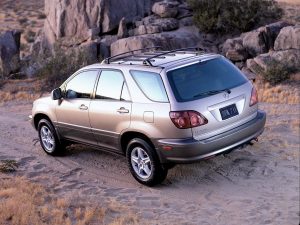
Somethings else, to be precise.
You can pick an RX (the $48,600 RX350) with a turbocharged four cylinder engine that makes a bit less power than the previously available V6 – or you can pick an RX (the $50,750 RX350h) with a turbocharged four paired with a mild hybrid system that goes much farther per gallon than the previous RX350 with the V6.
Or you can pick a plug-in hybrid version of this Lexus – the $69,230 RX450h – that has more power than the old V6 RX that also can be driven close to 40 miles without burning any gas at all. This model also doesn’t have to be plugged in when it runs low on charge – unlike an electric-only vehicle.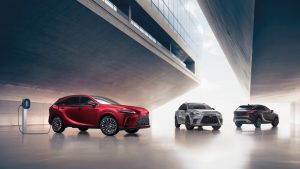
The fourth iteration of the RX is the $62,750 500h. It’s a performance hybrid that has more power (366 horsepower) than any previous RX even though it’s also powered by a turbocharged four. It gets better gas mileage than the turbo-four-only RX350 – which burns more gas because it lacks the hybrid-assist.
What’s New For 2024
The plug-in RX450h is new for this model year. Cloudhouse Gray has been added to the available color palette.
What’s Good
Multiple drivetrain choices.
Rear seats can be reclined.
12 speaker premium audio system and three-zone climate control are standard in base RX350.
What’s Not So Good
No more standard V6.
Standard 2.4 liter four only returns slightly better gas mileage than previously standard V6 – and is down 15 horsepower vs. the previous V6.
No third row option.
The previous RX – going all the way back to the first RX of the late 1990s – came standard with a V6. It was one of the most desirable attributes of the RX, not simply because it was a V6 but because it was one of the best V6 engines available – as established by its track record for reliability and durability as well as its smoothness.
So how come the new RX no longer comes with that V6?
For the same reason that the new Camry sedan, the new Tacoma pick-up, the 4Runner and other Toyota/Lexus models have given them up. That reason being the need for Toyota/Lexus to squeeze ever-higher gas mileage numbers out of ever-smaller engines, to placate the feds. And also because – in theory – a smaller engine emits less gas, specifically carbon dioxide, the gas that doesn’t have anything to do with air pollution.
In practice, the reduction of these “emissions” doesn’t amount to much – because in order to produce power comparable to a six cylinder engine, a turbocharged four cylinder engine relies on boost – the forcing of more air (and the spraying of more fuel) into the smaller engine’s cylinders. When not under boost, the smaller engine is more “efficient.” And “emits” less C02.
But – Catch 22 – it is almost impossible to drive a vehicle so equipped without relying on boost to get it going – without driving it very slowly. In which case, why bother with making it powerful in the first place? Why not just get everyone to drive something under-engined and slow? The answer of course, is that most people – especially people who spend Lexus money on a vehicle – don’t want to drove a slow, underpowered vehicle.
It’s all a big game – and everyone loses.
But on paper, there’s a gain – or rather, a reduction. And that’s why no more V6 for the RX.
The RX’s new standard engine is a turbocharged 2.4 liter four cylinder engine that makes 275 horsepower – 15 down from the previously standard 3.5 liter V6’s 290 horsepower – but your consolation prize is 22 MPG in city driving and 29 MPG on the highway, vs. 20 city and 27 on the highway from the no-longer-available V6.
There are some alternatives – just none with six cylinders.
The first is a hybrid set-up (in the RX350h) that combines a slightly larger 2.5 liter engine with a battery/motor, the latter driving the rear wheels. This combo makes less power (246 horsepower) but the gas mileage goes up significantly – to 37 city, 34 highway. And so does the range – which increases to 636 miles in city driving and 584 on the highway.
Interestingly, this hybrid uses a nickel metal hydride battery rather than lithium ion. The former are desirable because the chemistry is more stable. It’s probably part of the reason why Toyota/Lexus hybrid batteries have a reputation for safety and longevity, too.
Next-up is a plug-in hybrid set-up that increases the powertrain’s total output to 304 horsepower. This version of the RX – the 450h – can also be driven for about 37 miles on battery power alone (assuming you start with a full charged battery).
Finally, there’s the performance-hybrid RX500h. This one has the most horsepower (366) Lexus has ever offered in the RX, which enables it to hustle to 60 MPH in just over 5 seconds – making it the quickest-ever RX. It also gets slightly better gas mileage – 27 city, 28 highway – than the base RX350.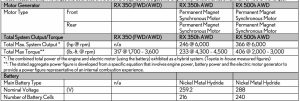
Irrespective of trim/powertrain, every RX is rated to tow up to 3,500 lbs.
The upside is you don’t have to spend extra on a higher trim to get the maximum rated towing capacity. The downside is that even the very powerful RX500h isn’t rated to pull more than the base RX350 – and several of the RX’s rivals, such as the Acura MDX, can tow as much as 5,000 lbs. when equipped with their optional (six cylinder) engines.
Lexus has done a thorough job making the new four feel (and even sound) like the V6 you used to get in the RX. It pulls with the authority of more than just four cylinders, which in a way is exactly what you’ve got here in that the turbo stuffs as much (or more) air into those four cylinder as six would be able to inhale, by themselves. And the power – the torque – is at hand sooner, which is the chief boon to this layout, as opposed to the nominal increase in posted gas mileage numbers.
The 2.4 liter four in the base RX350 may be down 15 horses vs. the previous V6. But it’s up – to 317 ft.-lbs. of torque (at 1,700 RPM) vs. just 268 ft.-lbs. (at 4,700 RPM) out of the previous 3.5 liter V6.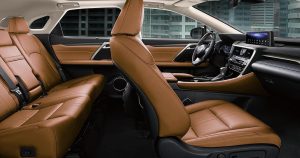
That translates into a stronger feel in the low and mid-range, where most people do most of their driving. Only when you floor it – and hold it – at high speeds, such as when you’re already doing 70 and want to pass someone quickly, does the 2.4 liter engine feel (and sound) a little winded. Lexus addresses the sound of being winded in the RX500h by augmenting the sound of the 2.4 liter four, which sounds larger than it is when you floor it.
This one also has the power to accompany the sound.
Regardless, it’s what hasn’t changed that’s most important – to people who love the RX. This Lexus is as soft as ever, if not more so. Even the 500h, which comes standard with the F Sport upgrades that include a set of very tall (21 inch) wheels – which you’d think would impart a stiff and unforgiving (as of potholes) ride.
They don’t. Because they’re not shod with rubber band-thin “sport” tires, as is usually the case with tires this tall.
What you do get is sharpened up steering response, which is an attribute almost everyone likes when it doesn’t come at the cost of a harsh and unforgiving ride. Even the sport buckets that are part of the F Sport package are more supportive than cinching.
The center-console-mounted toggle-style gear selector lacks physical feedback and (given it’s an entirely electronic input device) Lexus might as well have used buttons for Park, Reverse and Drive. This could have freed-up some more on space on the center console to allow for larger cupholders.
But – overall – the latest RX remains a lot like the old RX in spirit if not mechanically.
When the RX made its debut some 26 years ago, it looked like nothing else. Now everything else looks like the RX.
That is flattering – to Lexus – but it also means the latest RX doesn’t stand apart from the crowd as the original RX did. It is a victim, in a way, of its own brilliance. Were Lexus to significantly alter the shape of the RX, then the RX would no longer offer the packaging attributes that have made crossovers as popular as they have become.
So, the RX’s visual distinctiveness is mostly viewed from head-on, as is true of other crossovers. And that may explain why the current RX has a much more visually aggressive face than the original RX. It’s hard to miss the big “L” for Lexus badge in the center of the huge, trapezoidal grille that has become the trademark “Lexus” grille.
Inside, there’s a new, all-flatscreen instrument cluster, along with the now ubiquitous LCD screen for the secondary systems. It’s interesting to note that the original ’98 RX300 was one of the very first new vehicles to come with an LCD display and now – of course – everyone has one of those, too. Premium trims get a larger (14 inch) screen that’s easily twice the size of the ’98’s screen.
Tesla-style button-push door “pulls” unlock the door without needing to pull (or grab-handle) anything and an available low-speed self-driving system – Lexus Traffic Jam Assist – are among the modern ease-of-use upgrades meant to set the RX apart from other crossovers that look like the RX but don’t offer such features.
One thing the RX no longer offers is a third-row seating option, which some of the others in this class – including the Acura MDX – do offer. The italics to make a point of the fact that – for awhile – Lexus did offer a three-row version of the RX (the RX350L) but it didn’t sell very well because (apparently) people who like the RX don’t mind that it doesn’t offer as much utility as some of the others in the class, like the MDX.
What matters, to the people who buy the RX, is that it isn’t an MDX. Or anything other than an RX.
The Rest
Though Lexus has throughly updated the RX’s tech, the RX still has some old school tech to go along with it, including a 12V power point just ahead of the gear selector and alongside the modern USB/power points (both types). This is a small but big thing, if you have an accessory that uses a 12V pigtail plug – which you wouldn’t otherwise be able to use.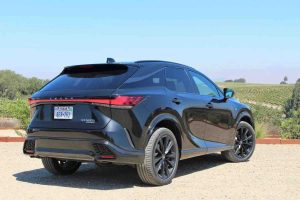
The base RX350 can be had with a digital key that enables you to use your smartphone to unlock and start the car. But you have to buy one of the more expensive trims to be able to order the well-worth-ordering 21 speaker Mark Levinson premium audio system.
Sadly, there’s no longer a CD slot – because everything’s digital now.
The Bottom Line
The V6 is gone but everything else that has made the RX the leader in its class for more than a quarter century remains.
. . .
If you like what you’ve found here please consider supporting EPautos.
We depend on you to keep the wheels turning!
Our donate button is here.
If you prefer not to use PayPal, our mailing address is:
EPautos
721 Hummingbird Lane SE
Copper Hill, VA 24079
PS: Get an EPautos magnet or sticker or coaster in return for a $20 or more one-time donation or a $10 or more monthly recurring donation. (Please be sure to tell us you want a magnet or sticker or coaster – and also, provide an address, so we know where to mail the thing!)
If you like items like the Baaaaaa! baseball cap pictured below, you can find that and more at the EPautos store!






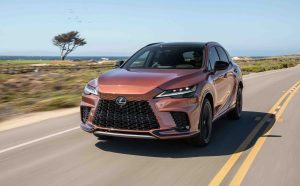
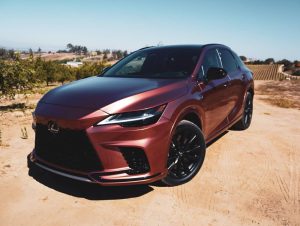







And what’s not new with Lexus. Still so ugly I wouldn’t buy one no matter how well made.
FIRE……..
People are charging the lithium batteries in their scooters, bikes, etc…..in their houses, apartments…..and their EV’s in their garages….this is risky because these lithium fire bomb batteries can catch fire…..there is lots of fires but the MSM is silent….
Why are these dangerous products being sold to the public with no warnings?
No warnings….the MSM doesn’t say a word….
NOTE: Lithium dendrite formation, i.e., a neural-like network of metallic growth that can form at the anode/electrolyte solid/liquid interface during charging, is a main challenge in terms of safety and durability of the Li-ion battery technology, since they can short circuit the battery cell and cause the battery to catch fire….they should be banned….
https://www.sciencedirect.com/topics/engineering/lithium-dendrite
Ford Lightning Price Cut “Sends Shockwaves Through EV Market”
The model now starts at around $67,995…..this screws all previous buyers…..their truck is worth less now….
“Reports of Ford reducing prices for the F-150 Lightning EV are sending shockwaves through the EV market, particularly affecting Rivian and Lucid,”
https://www.zerohedge.com/markets/ford-lightning-price-cuts-sends-shockwaves-through-ev-market
Lotus went all in on EVs…it used to sell great 1200 lb sports cars….soon it will only sell a 4000 lb EV……it is now chinese owned….
Lotus has reported a net loss of about $751 million for 2023….
Lotus sold 6,970 vehicles for an average loss of $107,747 per vehicle sold!
From the ZH comments…..
Just had lunch with a friend who drives an EV. It’s a company car, provided to him. He spent ten minutes of our time telling me what a pain it is to drive the thing around and try to find chargers in areas where it’s safe to sit in the car for an hour while it’s charging…..you could get raped, robbed or killed…..
https://www.zerohedge.com/markets/ford-lightning-price-cuts-sends-shockwaves-through-ev-market
And knowing the guy, his company probably does not allow him to have a gun for self-defense in said EV (that he is sitting, trying to charge), so he is even more screwed. If the EV does not burn him alive, first.
Hi Anon,
Yesterday, they picked up the RX500 and dropped off a Hyundai Ioniq6 EV. Ordinarily, the driver arrives around 10 a.m. to do the swap. Yesterday, he got here around 4 p.m. – no doubt because he had to stop and wait to charge the EV before he could make it here. It arrived here with 197 miles of indicated range, which means I can drive it about 100 miles before I either have to wait a day or longer for it to charge at home or wait ay some “fast” charger for 45 minutes to recover a partial charge. I cannot imagine willingly agreeing to live this way.
Now, if the EV cost 40 percent less than an equivalent gas-engined car, ok. That makes sense. Or at least, the inconvenience might be worth the savings. But to pay more for the inconvenience?
Beam me up, Scotty.
All the new cars are horrible and look terrible…why?
Because they are all built for the biggest car market now…China…
The new cars look terrible, even the new buildings look terrible too, there is no good design anymore….
Cars can be built for 40% less in China then in Europe….China will soon be the only car manufacturer?
For young people…in the old days…. getting a driver’s licence opened up the world to them…not today….cars are too expensive….so young people get a cell phone and disappear into the virtual world….conditioning them for the 15 min city/prison….
https://www.youtube.com/watch?v=RGGiAa7Ph8o
This reminds me of the screen quote adaptation of George Orwell’s, “1984”: The people will not revolt. They will not look up from their screens long enough to notice what is happening”. How sad (and scary) that such a phase would apply to today, albeit, I-Phone screens instead of television ones. Even more sad, is that most of these folks will not mind their enslavement, so long as they have their stupid phones in their face.
Speaking of hybrids, in an article about the strong growth of hybrids in Ford’s line-up, an exec just can’t stop himself from blabbing the obligatory leftist mantra:
“We know the end destination on electrification and EVs, but the tail on internal combustion engine and hybrid propulsion is much longer than anyone may have predicted earlier, a couple of years back,” said Jim Baumbick, Ford’s vice president for product development operations and quality.
https://tinyurl.com/474ssdam
So what you’re telling us, ‘Jim,’ is that ICE and hybrid vehicles are headed for the same fate as Windows 7: ‘support discontinued.’
Actually, with your deranged EeeVee fantasies, you’re just drafting Ford’s toe tag for when it ends up in the corporate morgue, the victim of massive malinvestment rubber-stamped by mindless true believers like yourself.
Don’t say I didn’t warn you, ‘Jim.’
“We know the end destination on electrification and EVs”
Some of us do.
Another top notch review from Eric on the latest Lexus offering.
But Lexus RX500h, hmmm, sounds familiar…
(checks notes)…
oh yes, in 2010, there was a RX450h, with the V6, and a 32 city/28 Hwy…
What have we lost in the ensuing 14 years???
Freed(umb)om from more Government intrusion and overreach…
To tell you the truth, I didn’t even make the mental connection that RX350 is (was) supposed to connote 3.5 liters of thumping V6 under the hood.
RX500h sounds like somebody’s license plate number … or a fake ‘skunk works project code’ dreamed up by the marketing department. No more animal-kingdom poetry as in the Mustang, Barricuda or Impala of yore.
Eminently forgettable letter-and-number combinations are a speciality of Eurotard auto makers. Unfortunately the Japanese decided to copy them. Then the Koreans and Chinese will copy the Japanese, till we end up with an FU69LOL turbocharged clown car with an ‘engine’ the size of the two matchboxes.
So what / who cares …
“No more animal-kingdom poetry as in the Mustang, Barracuda or Impala of yore.”
By design. Automotive design was once semi-artistic in nature. One of the Marxist tenets is to make all art ugly. Destroy beauty.
Curves get boxy. Chrome makes way for painted plastic. Poetically conceived nomenclature becomes computer code-like.
‘One of the Marxist tenets is to make all art ugly. Destroy beauty.’ — Philo Beddoe
A very perceptive observation, Philo. Vehicles such as the Lexus RX500 have evolved a long way from the brutalist style of the Trabant. Problem is, EVERY luxury crossover looks the same now — stamped from the same Govco-compliant mold.
Peculiar, individualistic, iconoclastic vehicles of the past are impossible now, because they are presumed unsaaaaaaaafe.
Been burned by under engined vehicles in the past. So no sale Toyota (and the others). Put the right size engine in it.
They think they have tricks to get around “there is no replacement for displacement” but in the long term there really isn’t. Too complex and expensive. It will be ok for the first owners, but for long term, second and third owners, these vehicles are going to be problematic.
But me thinks (pirate voice) that is a feature, not a bug (aka: getting gas powered vehicles off the road). They can’t have vehicles lasting over 10 years, let alone 20 or 40.
I have a 2022 Lexus RX350L that I bought brand-new from the dealership. It has a naturally-aspirated V6, and doesn’t take Premium gas. I love it. It’s smooth and the engine will no doubt be reliable for years to come. If for some reason it gets crashed, I’ll make sure it’ll be replaced with another naturally aspirated V6. It’s a shame how much the feds have interfered with the free market.
Hi Mark,
Yup. My mom bought an RX300 back in 1998 – and my sister is still driving it daily. These things were (and are) just great vehicles. I am saddened to see the V6 that made it so go.
I have a 2022 Lexus RX250L that I bought brand-new from the dealership. It has a naturally-aspirated V6, and doesn’t take Premium gas. I love it. It’s smooth and the engine will no doubt be reliable for years to come. If for some reason it gets crashed, I’ll make sure it’ll be replaced with another naturally aspirated V6. It’s a shame how much the feds have interfered with the free market.
Nice review as always, Eric. Lexus has always made such top notch vehicles.
I just can’t get past that grill, though. Well, that and the price tag!
I must admit that I’m mystified by the “inverted” gas mileage numbers (better mileage in city driving than highway) that accompany these hybrids. In a real car or truck (i.e., gas-powered), I thought highway mileage was higher because city driving is characterized by stopping-and-going, where the light turns green, you burn some fuel to give the vehicle kinetic energy, then the light a block or two ahead turns red, and you use the brakes to turn that kinetic energy into (waste) heat. Are these hybrids being regeneratively braked?
As you can see, I’ve been driving old iron exclusively. And happy to have been doing so.
Hi James,
The reason hybrids get better mileage in stop-and-go “city” driving is because the engine is often off. Whereas on the highway, it is almost always on.
I see one very small advantage and I’m not totally sure they do it, but the regenerative braking feature to feed back energy to the battery. I have always liked this aspect of the hybrids. But not enough for me to sell my TDI.
Thanks, Eric; that makes sense. If I may ask one more question, revealing myself as a real dinosaur: are these hybrids actually propelled by motor(s), with the real engine’s only task being keeping the battery charged? And, if so, do these propulsive motors then act as motor-generators, and return charge to the battery during braking? (OK, that’s TWO questions. I’m greedy.)
I can answer this one. The motors work together because that’s more efficient. The Toyota/Lexus have a genius planetary transmission which connects one gasoline engine and two electric motors and they can simulate any “gear” by running the electric motors in a particular direction and power. They can even do really cool stuff like having one motor and the engine force the third motor to act as a generator, burning a bit of extra gas to charge the battery. This kind of system is called a “parallel hybrid” because both powertrains can work in parallel. What you described, where the engine is a generator is called a “series hybrid”, and the only one that ever existed was the Fisker Karma. It’s less efficient to do this because when an engine acts as a generator only, conversion from motion to electricity back to motion is not as efficient as simply using the motion directly.
One of the motors is a motor-generator, the other one’s role is to direct the engine’s torque to specific places, either to the road or to the other motor/generator.
And to add to your first question, it takes less power to propel a car more slowly, since there’s less wind resistance and rolling resistance. Traditionally, gasoline engines were terrible at low speeds because they have a narrow efficiency spot, and that was tuned for highway travel, so the huge inefficiencies of gas engines at low speeds made us used to city driving being inefficient. EV’s are equally efficient at all speeds, and the slower you go, the less power you use per mile.
Great info, OL. Thanks!
EV’s are equally efficient at all speeds,….way wrong
At high speeds they use way more energy…they are far more efficient at low speeds…the main problem is they have a 1 speed transmission….they should not have been sold until this problem was fixed…they are not ready for consumer’s use….(Porsche does have their own 2 speed transmission)
A diesel is the opposite, also gas ice…..at high speed on the highway they get very good fuel economy….around town they use more fuel….they have an advantage…up to a 10 speed transmissions…with at least 3 over drive gears….
There was VW diesels getting over 80 mpg on the highway….EV’s average 25 mpg overall….
A Tesla driven at full throttle on a race track used 80 miles range in 8 miles….
A Mercedes EV at full throttle killed the battery in 100 miles….
An ice gas engine is the most flexible…some have a flat torque curve from 1800 rpm to redline….ice engines are great…they can be engineered to have a flat torque curve right to redline….or designed for the track with power and torque high in the rpm range…they can be engineered to have the HP and torque where ever you want it…..they can put out far more power then any electric motor…..
diesels have a narrower power band and a lower rpm limit…..but are great for constant speed applications…like in ships….because they are very efficient….
EV’s average 25 mpg overall….gas and diesel engines are far more efficient….but the liars try to trick people…..
Electric motors have full torque at 1 rpm…but…half way to maximum rpm the power starts to drop…at maximum rpm it is way down….that is one reason they have a low top speed in EV’s….and the reason they lost out to far more flexible gas engines and died out 100 years ago…now liars are trying bring back dead tech…..
I meant to say that electric MOTORS are equally efficient at all speeds. Notice that just before that, I said that efficiency is related to air resistance and rolling resistance. Electric motors do lose some efficiency at higher RPM due to back-emf but there’s all kinds of trickery to deal with that with fancy controllers.
Gasoline motors, however, have a consumption sweet spot, it’s a 2D table plotting load against RPM, and the sweet spot is very narrow. Here’s an example diagram:
https://en.wikipedia.org/wiki/Consumption_map#/media/File:Brake_specific_fuel_consumption.svg
The engine above is most efficient at around 2100 RPM and a pressure of 15 bar. Notice how small that sweet spot is. An electric motor has a similar chart, plotting RPM against torque, and the sweet spot is far, far larger.
In an ICE car, the inefficiencies of the power train mask the greater efficiency of moving more slowly – that was my point.
As for EV’s losing torque with RPM, the explanation is very simple. There are two limits. One limit is the maximum number of current (amps) the pack and wiring can deliver. The other limit is the maximum wattage the pack can deliver. EV’s use maximum amps until the voltage starts to drop, at which point you’re limited by wattage. So, if you’re putting 100kW to the wheels, it’ll be less torque at 60mph than at 50mph. It’s simple physics.
Don’t forget the other series hybrid: the Chevy Volt!
Nope, the Volt was EV-first, but when it was using the gasoline engine while moving, it was driving the wheels directly. This happened at low states of charge, and for precisely the reason that I mentioned; it’s inefficient to go from ICE -> electricity -> motor -> wheels. ICE -> wheels is much better, and the Volt has that mode.
Is this one where the engine shuts off at a stop light? Those are weird, I admit. Probably because I am not used to something like that. But, question: For vehicles with such a “feature”, is all that on/off switching harder on the engine, than if it just stayed on and running while sitting at the red light?
I never gave any thought as to how far a hybrid can go on the battery alone. Always was under the impression that the battery kept soccer mom’s AC running while stopped at a red light.
Hardly seems worth the expense.
The appeal of a plug-in hybrid gets better in high road tax states like California, where gasoline is heavily taxed. Gasbuddy says LA gas prices are between $4.49 and $4.74 this morning. If you have solar panels on your house because you thought you were going to sell back power at retail rates (CA eliminated net metering after too many people took advantage of the program, causing non-solar customers to foot the bill at a net loss and imbalances in the system), it would be better for you to charge up your car instead.
Lucky LA, we’re hovering around $6 here in the SF Bay Area.
How high did it get during the Plague?
About $8